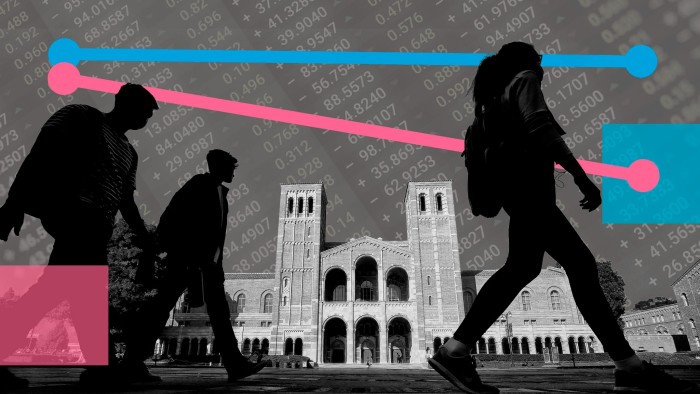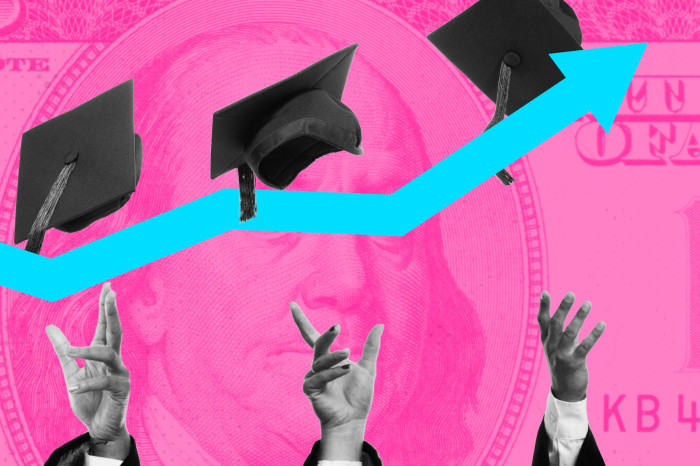The $1.6tn student debt quandary hanging over the US economy

Roula Khalaf, Editor of the FT, selects her favourite stories in this weekly newsletter.
The fate of the US economy depends on the vibrancy of the American consumer — and therein lies a mystery. No one is really sure when the tens of millions of people with federal student loans will have to start paying back their obligations. The amounts involved are not small — there is $1.6tn of such debt outstanding and the government has suspended collections on the great bulk of it.
The American way of financing higher education has long been a drag on the nation’s economy. All that borrowed money helps push up the already exorbitant cost of a degree. Many students, particularly in minority communities, struggle for decades to escape their loan burdens.
But the story has taken an unlikely turn during the pandemic. US student borrowers still owe a lot, but pay very little. Federal student loan forbearance programmes remain in place more than two years after they were begun by the Trump administration in the early days of the pandemic.
The current pause on collections of student debt is scheduled to end on August 31, but political observers expect the Biden administration to issue another extension — its fifth — to avoid riling voters in the run-up to November’s midterm elections for control of Congress.
Left unclear is whether there will ever be sufficient political will in Washington to move beyond the payment moratorium and replace it with policies that will hopefully make it easier for Americans to obtain higher educations without risking penury.
Prominent Democratic lawmakers have called for cancelling student debt of up to $50,000 per borrower. President Joe Biden is said to favour forgiving around $10,000 each for people making under $125,000. Republicans oppose debt cancellation, with the party’s Senate leader Mitch McConnell calling it “a giant slap in the face to every family who sacrificed to save for college”.
The uncertainty about the current direction of the US economy will only make the decision more difficult. Mark Zandi, chief economist of Moody’s Analytics, says high inflation is diminishing the appetite for debt forgiveness, while recession fears will make it harder to resume collections. In other words, this political can is going to be kicked down the road.
“At some point, the federal government has to make a decision. It can’t continue with a moratorium forever,” said Zandi. “But it feels like we are stuck in amber on the student loan issue until the economy navigates through this period of high inflation and high recession risk.”
The stakes are high. US student loan debt stood at $1.6tn in the second quarter, or $700bn more than Americans borrowed on their credit cards, according to the Federal Reserve Bank of New York. Most of the money is owed to the federal government.
Under the US forbearance effort, the collection of federal student loan payments and the accrual of interest was suspended, while delinquent borrowings were marked as current. New York Fed economists estimate that around 38mn borrowers have received relief and loan payments of about $226bn have been waived so far. A Philadelphia Fed report said that “nearly four out of five student borrowers have skipped some or all scheduled payments since April 2020”.
How has student loan debt shaped your life?

We want to hear from readers who took out a loan to pay for college in the US. Please share your thoughts via a short survey, and we might feature your experience in an upcoming story.
The resulting improvements in consumer finances were documented in a New York Fed report published this month. It found that the credit scores of 79.1 per cent of student loan borrowers rose during the pandemic, a more dramatic improvement than was registered in the two-year period before Covid-19 hit.
Yet New York Fed economists wonder whether such gains may prove to be fleeting. They were encouraged that some of the credit score improvements reflected the reduction of credit card utilisation rates by borrowers. On the other hand, they found that some delinquent borrowers registered dramatic improvements in their scores simply because their loans were marked as current under the forbearance programme.
Resuming federal student loan collections of some kind will require the authorities to move with care. While forbearance has obviously helped borrowers, it has also obscured the struggles of many of them during the pandemic. We will only find out how they are doing later.
The report by Philadelphia Fed economists paid particular attention to “a significant share of education borrowers” who they described as “chronically struggling”. Many of these people took on student debt but failed to receive a degree or find a job in their area of specialisation.
“Borrowers with chronic repayment challenges benefit from automatic forbearances,” the report’s authors observed, “but our survey responses suggest that for most of these borrowers, forbearance is simply postponing a day of reckoning.”
Letter in response to this article:
Here’s a neat solution to US student debt quandary / From Benedikt Koehler, London SW1, UK
Comments